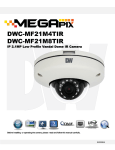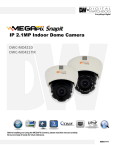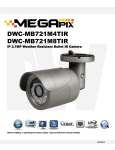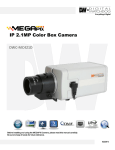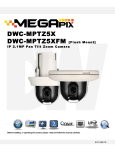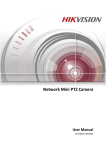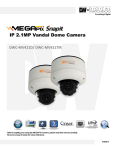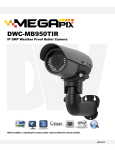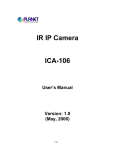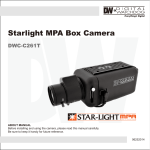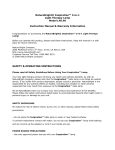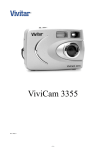Download DWC-MPA20M Manual
Transcript
DWC-MPA20M IP 2.1MP Armored Vandal Dome Camera Before re installing or operating the camera, camera please read and follow this manual carefully. carefully 04132012 PRECAUTIONS Do not open or modify. Do not open the case except during maintenance and installation, for it may be dangerous and can cause damages. Do not put objects into the unit. Keep metal objects and flammable substances from entering the camera. It can cause fire, short-circuits, or other damages. Be careful when handling the unit. To prevent damages, do not drop the camera or subject it to shock or vibration. Do not install near electric or magnetic fields. Protect the camera from humidity and dust. Protect the camera from high temperature. Be careful when installing near the ceiling of a kitchen or a boiler room, as the temperature may rise to high levels. Cleaning: To remove dirt from the case, moisten a soft cloth with a soft detergent solution and wipe. Mounting Surface: The material of the mounting surface must be strong enough to support the camera. FCC COMPLIANCE This equipment has been tested and found to comply with the limits for a Class B digital device, pursuant to Part 15 of the FCC rules. These limits are designed to provide reasonable protection against harmful interference, when the equipment is operated in a residential environment. This equipment generates, uses, and radiates radio frequency energy, and if it is not installed and used in accordance with the instruction manual, it may cause harmful interference to radio communications. WARNING: Changes or modifications are not expressly approved by the manufacturer. 2 TABLE OF CONTENTS* FEATURES. . . . . . . . . . . . . . . . . . . . . . . . . . . . . . . . . . . . . . . . . . . . . . . . . . . . . . . . 4 PARTS & DESCRIPTIONS. . . . . . . . . . . . . . . . . . . . . . . . . . . . . . . . . . . . . . . . . . . . . . . . . . 5 DIMENSIONS. . . . . . . . . . . . . . . . . . . . . . . . . . . . . . . . . . . . . . . . . . . . . . . . . . . . . . . . . . . 6 INSIDE THE BOX. . . . . . . . . . . . . . . . . . . . . . . . . . . . . . . . . . . . . . . . . . . . . . . . . . . . . . . . . 7 NETWORK CONNECTION. . . . . . . . . . . . . . . . . . . . . . . . . . . . . . . . . . . . . . . . . . . . . . . . . . . . . . . . . 8 INSTALLATION . . . . . . . . . . . . . . . . . . . . . . . . . . . . . . . . . . . . . . . . . . . . . . . . . . . 9 IP FINDER SOFTWARE. . . . . . . . . . . . . . . . . . . . . . . . . . . . . . . . . . . . . . . . . . . . . . . . . . . . 12 CAMERA REBOOT. . . . . . . . . . . . . . . . . . . . . . . . . . . . . . . . . . . . . . . . . . . . . . . . . . . . . . . . .16 WEBVIEWER. . . . . . . . . . . . . . . . . . . . . . . . . . . . . . . . . . . . . . . . . . . . . . . . . . . . . . . . . . . 17 TROUBLESHOOTING. . . . . . . . . . . . . . . . . . . . . . . . . . . . . . . . . . . . . . . . . . . . . . . . . . 12 SPECIFICATIONS. . . . . . . . . . . . . . . . . . . . . . . . . . . . . . . . . . . . . . . . . . . . . . . . . . . . . . . . . . . . . .16 WARRANTY INFORMATION. . . . . . . . . . . . . . . . . . . . . . . . . . . . . . . . . . . . . . . . . . . . . . . . . . . 17 LIMITS & EXCLUSIONS. . . . . . . . . . . . . . . . . . . . . . . . . . . . . . . . . . . . . . . . . . . . . . . . . . . . 12 3 FEATURES* ONVIF Conformant 1/2.7” CMOS Sensor (12% Larger than 1/3” CMOS Sensor) Highest Resolution 2.1 Megapixels 1080P (1920X1080) at 30fps 4.3mm Fixed Lens 8X Digital Zoom Power over Ethernet [PoE] & DC12V Web Server Built-in H.264 and MJPEG Dual Stream Electronic Day and Night 3D-DNR (3D Digital Noise Reduction) Programmable Privacy Zones (30) & Motion Detection Mirror E-mail Event Notifications Max 20 Users Panic Recording Export & Print Image IP66 Certified (Weatherproof) 4 PARTS & DESCRIPTIONS* 1. Lens 2. RJ45 Cable 3. DC Cable 4. IP Module 5. Bottom 6. Bottom Pad 7. Gimbal Tilt Stopper 8. Mounting Screws 9. Dome Cover Support 10. Dome Cover 11. Gasket Rubber 12. Upper Case Rubber 13. Upper Case 14. Assembly Screws M3.0 X 15.0 15. FA Buttons 5 DIMENSIONS* 6 INSIDE THE BOX* The following items are included with the MEGAPIX camera. 1 2 3 4 5 6 1. User Manual 2. Quick Start Guide 3. CD (Manual & Software) 4. L-Wrench (T10-M3X15.0) 5. 4 Screws & 4 Dry Wall Anchors 6. Mounting Template 1. Camera Input Sensor 2. Power Supply DC12V Max 5.16W, 430mA 3. RJ45 Connector 1 2 3 7 NETWORK CONNECTION * There are two options. Use a PoE-enabled switch to connect data and power through a single cable and begin viewing and recording images instantly. A non -PoE switch will require an adaptor for power transmission. 1. Using a PoE-Enabled Switch The MEGAPIX Camera is PoE compliant, allowing transmission of power and data via a single Ethernet cable. PoE eliminates the need for the different cables used to power, record, or control the camera. Follow the illustrations below to connect the camera to a PoE-enabled switch using an Ethernet cable. 1. Using a Non-PoE Switch If a PoE-enabled swithc is not u sed, use a power adaptor for power transmission and a non-PoE switch for data transmission. Follow the illustrations below to connect the camera without a PoE-Enabled Switch. 8 INSTALLATION* 1 2 1. Using the supplied L-Wrench (T10-M3X15.0), loosen the four security screws. Carefully remove the dome cover. 2. The MEGAPIX camera comes with a safety wire attached. The Safety Wire will secure the dome cover to the camera module during the installation process. To remove the safety wire, remove the screw that is keeping the wire in place. We recommend that you use the safety wire. 3 3. Use the camera mounting template or your camera to mark the holes as required. 4. Drill the holes into the drywall and insert the drywall mounts into the holes. 4 9 INSTALLATION* 5 5. Pull wires through and make connections. Connect the RJ45 to a CAT5 cable or power adaptor. Refer to “NETWORK CONNECTIONS” for further explanation. 6. Mount the camera to the wall or ceiling, using the screws provided with the camera. 7 7. Adjust the camera pan and tilt. See page11 for details. Check the LED light. Green light flickers when the camera is booting, and Red light turns on when booting is complete. 8. Tighten the four locking screws with the L-Wrench. 10 6 8 INSTALLATION* Adjusting the 2-Axis Gimbal The Gimbal mechanism yields maximum rotation and placement as shown below. Pan 360o Tilt 90o 11 IP FINDER SOFTWARE* Installing IP Finder Software IP Finder searches for all the available Digital Watchdog devices currently connected to your network. 1. Install IP Finder to find the MEGAPIX camera on your local network. The software can be found on the included User Manual CD. Run IP Finder and install onto your PC. 2. When setup is complete, launch IP Finder . 3. To find your MEGAPIX camera, click Search button. Your MEGAPIX camera will appear as ”DWC-MP.” 4. Select the desired device and click Web Connect to access the camera directly via Internet Explorer. *Make sure to install the IP Finder to a computer located on the same network segment (Subnet Mask) as the MEGAPIX camera. 12 IP FINDER SOFTWARE* Using IP Finder Software Use IP Finder to change the basic settings of your MEGAPIX camera or to connect to your MEGAPIX camera. 1. Configuration: Change the device’s connection type and/or IP address information. Please see the next page for further explanation. 2. Upgrade: Upgrade the device’s firmware. 3. Timezone: Change the timezone. 4. Import Config: Import setup configuration for a specific device. 5. Web Connect: Connect to the MEGAPIX camera through Internet Explorer. 1 2 3 4 5 13 IP FINDER SOFTWARE* Using IP Finder Software Use IP Finder to set the connection type and the IP address information for your MEGAPIX camera. 1. DHCP: Select DHCP to access the camera within the same internal network. For further explanation on DHCP, please see PAGE 15. 2. Static IP: Select Static to connect to the camera from an external network. For further explanation on Static, please see PAGE 15. 3. Use DDNS: Check this option to use DDNS service. For further explanation on DDNS, please see PAGE 15. 4. Port: Displays the port numbers that are required for communication. User can use IP Finder to change other basic settings for your MEGAPIX camera. (The menu will be different depending on the model.) 1 3 2 4 *If you decide to change the camera’s IP, make sure to write down the camera’s MAC Address for identification in the future. 14 IP FINDER SOFTWARE* DHCP The Dynamic Host Configuration Protocol (DHCP) is a network configuration protocol that allows a device to configure automatically according to the network it is connected to. If your network supports DHCP and your MEGAPIX camera is set to DHCP, IP Finder will automatically find and set your MEGAPIX camera to correspond with your network requirements. Static Static IP addresses are recommended when using a network that does not support DHCP or when setting your device to be accessed externally via the internet. If Static is selected, you must manually enter the correct network settings for your MEGAPIX camera. The settings will correspond with your network. To set your camera to a static IP address, we recommend that you (1) setup the camera to DHCP, (2) allow it to configure itself according to your network, and (3) change the settings to a static IP address. 1. To set your MEGAPIX camera to Static, highlight the desired device from the search results list, and click on Configuration. In the “Network Configuration” window, make sure Static is selected. 2. Enter the following information: IP Address, Netmask, Gateway, and Preferred DNS. 3. Click Apply and Reboot to save all changes. DDNS Dynamic Domain Name Server is a feature that allows you to use a specific URL instead of an IP address to access your MEGAPIX camera. This feature is optional. It may require a subscription and fee. 1. To use the DDNS feature, check the box next to Use DDNS. 2. Select the server you wish to use. *Some servers may require a subscription and fee. 3. If applicable, enter the User ID and Password. 4. Click Apply and Reboot to save all changes. 15 CAMERA REBOOT* Resetting the Camera Hold down SW4 and press SW4 to initialize all environmental variables to factory default. Previous setup (IP default, time, etc) will be deleted. If a system’s IP address is lost, reset the camera back to factory default. The following are the default network settings. IP Mode DHCP IP Address 192.168.1.123 Subnet Mask 255.255.255.0 Gateway 192.168.1.23 Command Port 7000 HTTP Port 80 Live Port 7001 SW5 Camera Reboot SW4 Factory Default *Frequent use may cause system error. 16 WEBVIEWER* Remote Video Monitoring Via Internet Explorer Monitor and configure the MEGAPIX camera through a built-in webviewer. 1. Type the IP address of the camera on the Internet Explorer window. Example: http://192.168.1.123 (Factory Default) 2. Enter Username and Password Username: admin | Password: admin 3. The web browser will ask to install ActiveX Control. Once it has been installed, Internet Explorer will display video images from the camera. 17 WEBVIEWER* Remote Video Monitoring Via Chrome, Firefox, or Safari You can view your MEGAPIX camera using web browsers other than Internet Explorer. To do so, at least one of the streams of the camera must be set to the codec MJPEG. 1. Open Google Chrome, Mozilla Firefox, or Apple Safari Web Browser. 2. Enter the IP camera's IP address. If the first stream is set to H.264; then a video will not be displayed on the GUI. 3. Click the Setup button located at the top right of the page. Then go to Video > Stream Settings. 4. Modify one of the two (2) streams to the codec MJPEG. 5. When you are finished modifying the streams, click Apply and Reload to make sure all changes have been saved and your camera has been rebooted. 6. Click on Live View to return to the camera’s main page. 7. At the bottom of the page, select the stream you set as MJPEG. The camera will begin streaming video. 18 WEBVIEWER* First Stream & Second Stream Configure two stream settings for monitoring and recording. On the main monitoring page, user can view the camera with the First Stream settings or the Second Stream settings. Below the display screen, click on the First Stream and Second Stream buttons to view the different camera settings. To Setup Stream Settings, refer to PAGE 24. 19 WEBVIEWER* Export Image Export a screenshot of the current live video to your computer. 1. Click Export Image button located on the left. “Save As” window will appear. 2. Select the folder you wish to Save In and type in a File Name. 3. Click Save button and the screenshot will be saved. 20 WEBVIEWER* Print Image Print a screenshot of the current live video. 1. Click Print button, and the Print Preview window will appear. 2. Scale the size of the screenshot or adjust the orientation of the screenshot. 3. To print the information about the screenshot, select View Title. To add a memo for the screenshot, click Page Option. 4. Go to Printer Setup to select the printer and manage the printer properties. 5. Select Print to print the page, or Close to cancel the print. 21 WEBVIEWER* Instant Recording Record live video to your local drive. To Setup Instant Recording 1. Click on the Record button located to the left of the Webviewer. 2. Setup where you want the videos to be saved. 3. Setup the duration of the instant recording. You can record up to 120 seconds of live video. 4. When setup is complete, click OK to save changes or Cancel to cancel any changes. 22 WEBVIEWER* Instant Recording Record live video to your local drive. To Start and Stop Instant Recording 1. To Start, right-click anywhere on the display screen. 2. Click on Start Rec. The icon on the top right of the screen will change to INSTANT. 3. To Stop, right-click anywhere on the display screen. 4. Click on Stop Rec. The video will be displayed in the designated folder when recording is complete. 23 WEBVIEWER* Setup > Video > Stream Settings User can setup two different streams for the MEGAPIX camera. • Name: Set a distinguish name to each stream to identify each one of them. • Resolution: Set Resolution for each stream. The better the resolution of the video, the more bandwidth it will require to stream images. • Compression Type: Select the type of compression to use when outputting the video. • Data Transfer Speed: Set encoding bitrate if H.264 and MJEPG compression type is selected. • Framerate: Select from 0fps to 30fps. • MJPEG Quality: Set MJPEG image quality. This is only available when the compression is set to MJPEG. The higher the quality, the more bandwidth will be required to stream the image. 24 WEBVIEWER* Setup > Video > Color Settings The Recommended Stream Settings are indicated on the image to the left. This is also the factory default settings. Adjust the Color Settings for your MEGAPIX camera. White Balance: Also known as Color Balance. This gives the camera a reference to “true white.” Select from Auto, Auto_H, Auto_L, or Preset. Auto Exposure Brightness: Select from 0 (darkest) to 20 (brightest). Shutter Mode: Set the amount of light allowed in the video manually or automatically. Digital Slow Shutter: Recommended in low light conditions. Turn On or Off. Shutter Speed: Select the speed the camera’s shutter will operate—1/30, 1/60, or 1/120. AGC Gain: Maximum light gain settings in low light conditions. Select from 0 (least light) to 20 (most light) . BLC (Back Light Compensation) Mode: This setup allows the camera to process an image that is harshly silhouette against a bright light source. 25 WEBVIEWER* Setup > Video > Color Settings The Recommended Stream Settings are indicated on the image to the left. This is also the factory default settings. Adjust the Color Settings for your MEGAPIX camera. Day & Night: Set the mode to Night, Day, or Auto. If set as Auto, set a desired Color to B/W Level and B/W to Color Level. Color to B/W: Select from 0~10. The higher the number, the less darker the environment will have to be for the camera to switch from color to B/W. B/W to Color: This number should always be lower than the number set to color to B/W. Extra Settings Lens mode: Set the camera to indoor/ outdoor lighting environment. Chroma: affect the quality of the color in the image. Select from 0~20. The higher the numbers, the video will have brighter colors. Sharpness: Select from 0~10 the sharpness of the image. Mirror/ Flip: Mirror the image from left to right, or flip it upside down. Digital Noise Reduction: control the level of noise in the image. Select from Off / Low / High. 26 WEBVIEWER* Setup > Video > Privacy Zone The MPA20M camera offers up to 30 privacy zone settings. To set Privacy Zones: 1. Change Mode to On. Click Apply. By default, all 30 privacy zones will be displayed. 2. Select the zones you want to view and/or modify. Use the Show All button to display all 30 privacy zones, or Hide All to deselect them and select only a single privacy zone. After selecting the privacy zone you want to modify, click Apply. 3. Set the zone’s size and location, using the grid lines. In Local Settings, select the zone you want to modify. Horizontal Position: 0~57 Vertical Position: 0~31 Width: 0~60 Height: 0~34 4. Click Apply after each modification to make sure the size and position match your requirements. 5. Select the color of the zone from the drop down list. 6. When you are finished click Apply. 7. Click Reload to make sure all the changes you have made were saved successfully. 27 WEBVIEWER* Setup Video > Motion Detection The Motion detection feature allows the MEGAPIX camera to detect motion and trigger an alarm. To set the camera to send e-mail notifications for every motion triggered alarms, see PAGE 34. 1. Sensitivity: Select from Low, Middle, or High. 2. Dwell Time: When a motion is triggered, the camera can be set to record for a certain period of time. Dwell Time can be set up to 60 seconds. To setup specific areas of the camera’s view to motion detection, please see the next page. 28 WEBVIEWER* Setup Video > Motion Area The motion detection feature allows the MEGAPIX camera to detect motion and trigger an alarm. To set the camera to send e-mail notifications for every motion triggered alarms, see PAGE 34. 1. Hold left mouse button and drag the mouse pointer to select the motion area, or use Set All button to select the entire screen. 2. Select Clear All to deselect the selected motion areas. 29 WEBVIEWER* Setup > Event > Emergency Alarm Send alarm triggered information to predefined destination (i.e. remote client software). 1. Enter the Site Name, Transmission Settings, and Video Duration for the video that will be sent when motion is detected. 2. Enter the IP Address and the Port for the remote site to which you want to send the video. You can set up to five different servers. 30 WEBVIEWER* Setup > Network > Network Settings 1. Select the type of IP address for the camera. DHCP: IP is assigned automatically. PPPoE: Select this otpion, when you use WAN service. To use WAN service, you will need Username and Password from your Internet Service Provider. Static IP: Enter IP information on existing field, if you decided to give the camera a static (fixed) IP address. 2. Enter Primary DNS and Secondary DNS. 3. IPv6 offers a new 128-bit address system. You can use it to use an Automatic address generated by the network, or you can manually enter a Static address. 4. MAC Address displays the camera’s MAC (Mobile Access Control) Address. 5. Port displays all the ports necessary for network communication. 6. Reboot your system to apply the changes to your camera. 31 WEBVIEWER* Setup > Network > Dynamic DNS If you do not use a public IP address, DDNS provides you to connect on WAN. DDNS allows you to connect to the MEGAPIX camera with a URL address instead of an IP address. DDNS automatically redirects traffic to your IP address every time it changes. 1. To use DDNS, check Use DDNS checkbox. 2. Select one of the DDNS System Name from the drop down list. 3. Enter Username & Password. The Username & Password must be registered at the DDNS site. 4. Enter Host Name. 5. Reboot your system to apply the changes to your camera. 32 WEBVIEWER* Setup > Network > Communication Protocol Current Protocol displays the current selected protocol. 1. To change the Protocol, select one of the three options—TCP, UDP, Multicast. 2. If you select Multicast, enter the Multicast IP and Multicast Port. 3. Reboot your system to apply the changes to your camera. 33 WEBVIEWER* Setup > Network > Access Permission Use the Access Permission page to allow or block specific IP addresses to connect to the camera. 1. Select All Allow to allow anyone to connect to this camera. If All Allow is selected, the Allowed IP List and Blocked IP List will be ignored. 2. To allow only a specific list of IP addresses to connect to this camera, select Allow. Enter an IP Address and click Add button. 3. To block a specific list of IP addresses from connecting to this camera, select Block. Enter an IP Address and click Add button. 34 WEBVIEWER* Setup > Network > ONVIF ONVIF is the Open Network Video Interface Forum. 1. To use ONVIF, check Enable. 2. Set the Service Port to “8032.” 3. Select On or Off for WS-Security. 4. Select desired Options from the list. 5. Select On or Off for WS-Discovery (Web Services Dynamic Discovery) 6. Select On or Off for Verify Service Address. 35 WEBVIEWER* Setup > System > Upgrade Upgrade the MEGAPIX camera with an upgrade file. 1. System Version: Shows the current version of the camera. 2. Upgrade: To upgrade system firmware, you have to contact manufacturer and get the upgrade file first. Browse file and select the file. Then press Upgrade button. 3. Go to www.Digital-Watchdog.com and select Support tab. 36 WEBVIEWER* Setup > System > Date & Time Set date and time information. 1. Insert the Date and Time. Select the type of Format for your time. 2. Select your Timezone. 3. If you are located in a daylight savings area, check Automatically adjust clock for Daylight Saving Time option. 4. To synchronize with the NTP Server, check the option and type the NTP Server Address. Example: pool.ntp.org 37 WEBVIEWER* Setup > System > E-mail Notification Send an e-mail notification when an event is triggered. 1. Select Use Event Mail option. Select Event Type. 2. Enter SMTP Server information. Example: smtp.gmail.com 3. Enter Username and Password. 4. Enter Sender E-mail. 5. Add the E-mail(s) you wish to send the notifications to. *Email Notifications do not support TSL/SSL option. Notifications are TEXT only. 38 WEBVIEWER* Setup > System > User Access Control To add a new user, enter Username and Password and select a Permission type. Then, click Add. 1. Super: Administrator 2. Operator: View and Edit Video and Event Settings Only 3. Viewer: View Only To modify a user, select the user from the User List, and click Modify. To remove a user, select the user from the User List, and click Remove. 39 WEBVIEWER* Setup > System > Logs View User can view detailed logs for system and/or events triggered and recorded in the camera. 1. To view, select the type of report you want to view (System / Event / System & Event) and click on the View button. 2. The system will generate a report up to 140,000 bits of data. 3. For events to record, make sure the camera is set to record when an event, like motion detection, is triggered. See PAGE 27 for information on how to set motion detection for the MEGAPIX camera. 40 WEBVIEWER* Setup > System > System Information & Factory Default System Information will display all the current camera settings: System Version, Time Inforamtion, Network Information, Codec Information, Color Information, and Motion Detection. When you click Factory Default, the popup window to the left will appear. If you click OK, all your camera settings will erase and reformat to the factory default settings. *Factory Default will erase all your saved camera settings. 41 TROUBLESHOOTING Before sending your camera for repair, check the following or contact your technical specialist. I can’t find my MEGAPIX camera on the IP Finder software. Is the PoE cable connected properly? Make sure cable is tightly connected at both ends. It should make a “click” sound when connected properly. Make sure cable is intact and there are no cuts or exposed wires. If Yes, are the camera’s LED lights turned on and blinking? The camera’s LED lights indicate that the camera is powered on. Blinking LED lights indicate that the camera has finished booting up and is transmitting data. If Yes, is the internet working properly? Make sure you can connect to the internet with other devices on the network (ex. Your Computer). Your internet could be temporarily down. If Yes, if using a power adaptor, does it meet camera’s power requirements? Power Requirements: DC12V (5.16W, 430mA), PoE Ports (Class 2, less than 7W) If Yes, if using PoE Switch, is it connected to a proper internet outlet and operating properly? Make sure the PoE Switch is connected to a router/modem and the ports that have devices connected to them have a green LED on. If Yes, is the computer on the same network as the MEGAPIX camera? Camera and computer should be connected to the same router. Contact your network adminitrator if you have more than one network available. If Yes, try pinging the IP camera’s default IP address 192.168.1.123 From your desktop, go to Start > Programs > Accessories > Command Prompt. Type “ping 192.168.1.123” and press Enter. If you get the message “Request timed out,” cmaera is not connected. Camera is connected if you get data. If Yes, try connecting the camera to a differt port in the PoE Switch. That specific Switch Port may be damaged or currently not working properly. If Yes, try resetting the camera to default settings. Press the 2 buttons in the back together and hold for 5 seconds. The camera will return to factory deafult with default IP address 192.168.1.123. If your network supports DHCP, the camera will be found using the IP Finder software with an IP address that matches your network’s requirements. 42 TROUBLESHOOTING Before sending your camera for repair, check the following or contact your technical specialist. I can’t connect to my MEGAPIX camera through the Web Browser Are the camera’s LEDs on and blinking? The camera’s LED indicates the camera is On. If the LED blinks, the camera has finished booting up and is transmitting data. If Yes, is the internet working properly? Make sure you connect to the internet with other devices on the network (ex. Your Computer). Your internet could be temporarily down. If Yes, is the computer on the same network as the IP camera? Camera and computer should be connected on the same router. Contact your network administrator if you have more than one network available. If Yes, try pinging the MEGAPIX camera’s IP address as it appears on the IP finder. From your desktop, go to Start > Programs > Accessories > Command Prompt. Type “ping” followed by the camera’s IP address; then, press Enter. If you get the message “Request timed out,” camera is not connected. If you get data back, that means the camera is connected. If Yes, try connecting the camera, to a different port in the PoE Switch. That specific Switch Port may be damaged or currently not operating properly. If Yes, check your security settings on your internet browser. Try adding the camera’s IP address to the trusted sites list in your Internet Options. *Setup may vary depending on the browser you use. 43 TROUBLESHOOTING Before sending your camera for repair, check the following or contact your technical specialist. I can’t see the live video of my MEGAPIX camera. Are you trying to view the camera’s video from an Internet Explorer browser? Make sure you have the minimum PC requirements to view the MPA20M camera. *See below for more information. If Yes, did you install ActiveX files? When you connect to your MEGAPIX camera for the first time, your browser will ask you to install ActiveX. Make sure your Web Browser’s security settings do not blcok pop-up windows and allows ActiveX files to be installed and used. *Setup may vary dpeending on the browser you use. If Yes, make sure nothing is blocking the MPA20M camera’s lens. Are you trying to view the camera’s video from a different browser than Internet Explorer (ex. Google Chrome, Mozilla Firefox, MAC Safari)? If Yes, at least one of the streams of the camera must have Codec set to MJPEG. Go to the camera’s setup menu. Select Stream Settings. Select one of the streams and change its codec to MJPEG. Click Save and Reolad to save changes. Go back to live screen and at the bottom of the screen, select the stream you have set to MJPEG. Live video will start streaming to your web browser. Web Viewer Specifications Minimum Requirements for PC CPU Intel P4 2.0GHz Dual Core RAM More than 1GB HDD 200 GB Required for Saving Clip Image OS Microsoft Windows XP or Higher Resolution Higher than 1024X768 44 TROUBLESHOOTING Before sending your camera for repair, check the following or contact your technical specialist. Setting the IP Address for your PC Dynamic Host Configuration Protocol (DHCP) is the default setting for the camera. If the MEGAPIX camera is connected to a DHCP network and the camera’s IP Configuration Mode is set to DHCP, the server will automatically assign an IP address to the camera. If the camera is using DHCP, the default IP address will be 192.168.1.123, and the default subnet mask will be 255.255.255.0. The MEGAPIX camera can also connect to the webviewer using a static IP address. This will allow you to set your own IP address manually. Setup the Network Protocol on your PC. 1. Go to Network icon on your PC. 2. Right-click and select Properties. 3. Double-click Local Area Connection. 4. Click Properties. 5. Double-click Internet Protocol Version 4 (TCP/IPv4). 6. Select Obtain an IP address automatically to set the computer to a dynamic IP address, or select Use the following IP address to set the computer to a static IP address. 7. If the option Use the following IP address has been selected, setup the IP address as 192.168.1.XXX. The last three digits should be a number between 1 and 254. 45 SPECIFICATIONS* IMAGE Image Sensor 1/2.7” CMOS Sensor (12% Larger Than 1/3” CCD) Total Pixels 2016 (H) X 1108 (V) Minimum Scene Illumination F1.6 (30IRE): 0.8 Lux [Color] | F1.6 (30IRE): 0.01 Lux [B/W] LENS Focal Length 4.3mm Lens Type Fixed NETWORK LAN 802.3 Compliance 10/100 Lan Video Compression Type H.264, MPEG4, MJPEG (Super Fine~Low) Resolution 1920X1080 (16:9) ~ 320X240 (4:3) Frame Rate Up to 30fps at All Resolutions Streaming Capability Dual-Stream at Different Rates and Resolutions IP IPv4, IPv6 Protocol TCP/IP, HTTP, DHCP, PPPoE, ICMP, ARP, RARP, RTSP, NTP, UDP, Multicast Maximum User Access 20 Users Web Viewer Supported OS: Windows XP / Vista / 7, MAC OS Supported Browser: Internet Explorer, Google Chrome, Mozilla Firefox, Safari Video Management Software NxMS, Pivot Privacy Zone Off, On (30 Programmable Zones) 46 SPECIFICATIONS* ENVIRONMENTAL Operating Temperature -10oC ~ 55oC (14oF ~ 131oF) Operating Humidity Less than 90% (Non-Condensing) Storage Temperature -20oC ~ 70oC (-4oF ~ 158oF) IP Rating IP66 (Protects against Dust and High Pressure Water) Other Certifications CE, FCC, RoHS ELECTRICAL Power Consumption DC12V, PoE (IEEE802.3af Class 2) Power Requirement 5.16W, 430mA MECHANICAL Material Aluminum Dimensions 120 X 55.7 mm, 4.72 X 2.19 in Weight 0.728 lbs 47 WARRANTY INFORMATION* Digital Watchdog (referred to as “the Warrantor”) warrants the Camera against defects in materials or workmanships as follows: Labor: For the initial two (2) years, one (1) year for IR LED, from the date of original purchase if the camera is determined to be defective, the Warrantor will repair or replace the unit with new or refurbished product at its option, at no charge. Parts: In addition, the Warrantor will supply replacement parts for the initial two (2) years, one (1) year for IR LED. To obtain warranty or out of warranty service, please contact a technical support representative at 1-866-446-3595 Monday through Friday from 8:30AM to 8:00PM EST. A purchase receipt or other proof of the date of the original purchase is required before warranty service is rendered. This warranty only covers failures due to defects in materials and workmanship which arise during normal use. This warranty does not cover damages which occurs in shipment or failures which are caused by products not supplied by the Warrantor or failures which result from accident, misuse, abuse, neglect, mishandling, misapplication, alteration, modification, faulty installation, set-up adjustments, improper antenna, inadequate signal pickup, maladjustments of consumer controls, improper operation, power line surge, improper voltage supply, lightning damage, rental use of the product or service by anyone other than an authorized repair facility or damage that is attributable to acts of God. 48 LIMITS & EXCLUSIONS* There are no express warranties except as listed above. The Warrantor will not be liable for incidental or consequential damages (including, without limitation, damage to recording media) resulting from the use of these products, or arising out of any breach of the warranty. All express and implied warranties, including the warranties of merchantability and fitness for particular purpose, are limited to the applicable warranty period set forth above. Some states do not allow the exclusion or limitation of incidental or consequential damages or limitations on how long an implied warranty lasts, so the above exclusions or limitations may not apply to you. This warranty gives you specific legal rights, and you may also have other rights from vary from state to state. If the problem is not handled to your satisfaction, then write to the following address: Digital Watchdog, Inc. ATTN: RMA Department 5436 W Crenshaw St Tampa, FL 33634 Service calls which do not involve defective materials or workmanship as determined by the Warrantor, in its sole discretion, are not covered. Cost of such service calls are the responsibility of the purchaser. 49 5436 W Crenshaw St, Tampa, FL 33634 PH: 866-446-3595 | FAX: 813-888-9262 www.Digital-Watchdog.com [email protected] Technical Support Hours: Monday-Friday 8:30am to 8:00pm Eastern Standard Time


















































